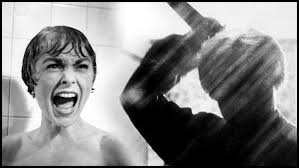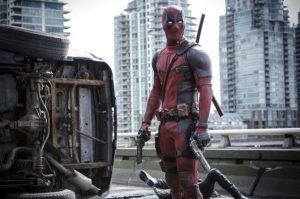WARNING: The links to film clips are graphic in nature. Viewer discretion is advised.
As the white shower curtains are drawn back, and the awaiting outline of the shady attacker wields his knife aloft, the iconic shriek of violins paired with the scream of sheer terror of has encapsulated cinema fanatics and casual movie watchers alike for decades. Everyone has seen it one time or another, the shower scene from the iconic Alfred Hitchcock movie “Psycho,” and yet, we forget how astoundingly revolutionary and scandalous it was. This revolution, however, sparked a slippery slope of movie violence for years to follow, paving the way for the continuation of exceeding amounts of blood to be splattered upon the silver screens of Hollywood.
In the following, I will be chronicling a brief history of the increasing infatuation with violence in a mix of Hollywood’s infamous mainstream movies, and the immense cultural impact it has had on generations of Americans.
Psycho – 1960
Alfred Hitchcock’s horror classic set the precedent for both the genre of horror and public celebration of the taboo in movies. The scandalous shower scene, a mere three-minute clip was shot for six days, features 77 different camera angles, and was edited over 50 times. Hitchcock wrestled with numerous censors when attempting to release the movie, mostly for the portrayal of outright murder with “graphic” stabbing sounds and “visible” nudity in the shower scene. This public pounced upon this attention, traveling to cinemas in swarms, and consequently breaking most box office records in Japan, France, Britain, South America, the United States, and Canada. Hitchcock personally received $15 million for the film (about $120 million today) and the film received $32 million in the US alone. The scene didn’t just capture the infatuation of the public but also traumatized actress Lila Crane, or the woman showering, Vera Miles, who stopped taking showers unless absolutely necessary and would lock all the doors and windows before bathing. Especially in a time of strict moral code and reserved views of sexuality and relatively crude portrayals of sadism, “Psycho” broke down established societal reservations and pioneered a graphic future of the portrayal of violence and murder in movies.

A Clockwork Orange – 1971
Featuring graphic scenes of rape and even preying upon a homeless cripple, “A Clockwork Orange” has a special place on this list. This movie was so violent, that it was declared 9th on Time’s Top Ten Ridiculously Violent Movies list. Stanley Kubrick’s film, released just eleven years after “Psycho,” set a new standard for the MPAA ratings. It was originally released in the US as an X-rated film on DVD, but after cutting 30 seconds of sexually explicit footage, it was lowered to R. It also exceeded many expectations at box office from the attention garnered from the scandals, bringing in more than $26 million on the conservative budget of a mere $2.2 million. The first look at A Clockwork Orange’s glorified violence is where Alex DeLarge, the main character, and his goons mercilessly beat upon a “filthy dirty old drunky” in the mask of nighttime. Surprisingly, this scene both wasn’t the most controversial, nor drew much attention from the censors. This scene is vitally important, however, in the landscape of the desensitization of violence for two reasons. First, the scene glorifies the abuse of power against the lower societal class or the undesirables, allowing Alex to get away with this cruel beating scot-free. And, the fact that it was overlooked for more raunchy provocative sexual scenes displays the American public’s early desensitization to violence.

Saving Private Ryan- 1998
Renowned as one of the greatest military scenes of all time by Empire magazine and ranked 1st in TV Guide’s “50 Greatest Movie Moments Ever,” “Saving Private Ryan’s” reenactment of the invasion of Normandy is one of the most accurate views of the horrific D-Day attack. This scene doesn’t have any reservations with gore, nor should it. Steven Spielberg actually used twenty to thirty real amputees to replicate the harsh reality of the battle. In an almost detached sequence of events (around the 5-minute mark in the hyperlinked video above), we see a soldier wandering about aimlessly, searching for the missing half of his blown off arm, until he finds it, picks it up and runs to rejoin the battle. Probably the most gruesome sequence of the scene is when the camera pans over a dying soldier, intestines and entrails in his blood covered hands for the audience to see as he screams out in agony for his mother. Even with all of this gore, there was no public outcry for harsher MPAA rating, no scandals, no release delays. The war aspect justifies Saving Private Ryan’s extremely violent nature. In a seventeen year span from the release of A Clockwork Orange, Steven Spielberg flourishes from a long built conditioning, the conditioning being the establishment of the desensitization of violence, evidenced by the lack of resistance to the films grisly content.

Kill Bill- 2003
With Quentin Tarantino being known for excessive violence within his movies, it’s a given that one of his films would be on this list. However, the most popular of his movies, “Pulp Fiction,” was left off intentionally; “Kill Bill” has that much more blood. Cinema’s trail of blood has brought us from scandal from a bathroom murder to the literal on-screen mutilation of 88 assassins at the hands of Uma Thurman’s katana-wielding heroine. Blood fountains, triple decapitations, and eye-gouges, the violence in this scene verges on the gory and comes closer to creative. Unlike “Saving Private Ryan,” there is absolutely no justification for the violence within “Kill Bill.” Unsurprisingly, any mother-son duo accidentally stumbling into the theater of “Kill Bill” would leave mortified, which led to the demonetization of Tarantino, mainly from protective mothers. The plot of “Kill Bill” is good old-fashioned revenge, and by revenge, “The Bride” exacts her unrelenting fury upon any and all of her victims, leaving each one of them in a pool of blood. “Kill Bill” represents the height of dramatic movie violence.

Deadpool – 2016
The epitome of overt and unrestrained violence, Deadpool’s public and critical acclaim parallels former notions of public acceptance of imprudent violence. The “controversy” sparked by Deadpool was the fact that it was the first R-rated Marvel film in years, breaking the longstanding tradition by the studios to make movies family-friendly to appeal to more audiences. However, Deadpool blatantly breaks that pattern, with the perfect antihero, Ryan Reynolds, exacting the perfect mix of profanity and bloodshed out of Deadpool to make droves of fans swarm to the theaters. And the people swarmed to the theaters as expected, amassing an unprecedented $341 million in the US and a stunning $731 million worldwide, all against a meager $51 million budget. Deadpool provided ample red band trailers to give potential movie-goers a plentiful look at the movie they were going to watch, and unsurprisingly, the red band trailers were watched about as many times as the regular trailers were. It was the second highest-grossing R-rated movie ever and was 8th most successful comic book movie, behind mammoths of films like The Avengers, The Dark Night, and Iron Man 3, all of which had much larger budgets. However, the explosive success of Deadpool was not only initiated by its stunning box office numbers, but also by the equally stunning violence.

After Kill Bill and Deadpool, people started asking the question: Why all the violence? The answer is: because it sells movies. If you haven’t noticed, violence has become more explicit since 1960 when the shower scene of “Psycho” set a fire under everyone, and sent them to the theater for a glimpse of the most gruesome murder they had ever seen. And the more people wanted to see blood, Hollywood accommodated and then some, desensitizing each and every American to appreciate and accept it on their screens, even celebrating it at “award shows” like the Oscars year after year. But although “Kill Bill” had some of the most violent scenes in cinema history, it wasn’t all that popular, and subsequently, the yearning for violence continued. So, as Deadpool’s massive success shows, over-the-top violence is still in. And, as the movie industry will, the next “Deadpool” type movie will be even bloodier, more explicit, and more profane. And soon, the American populous will probably get bored with all the blood, and the cycle will repeat with something else more scandalous. But who knows, all of this started with a knife and a shower curtain.
